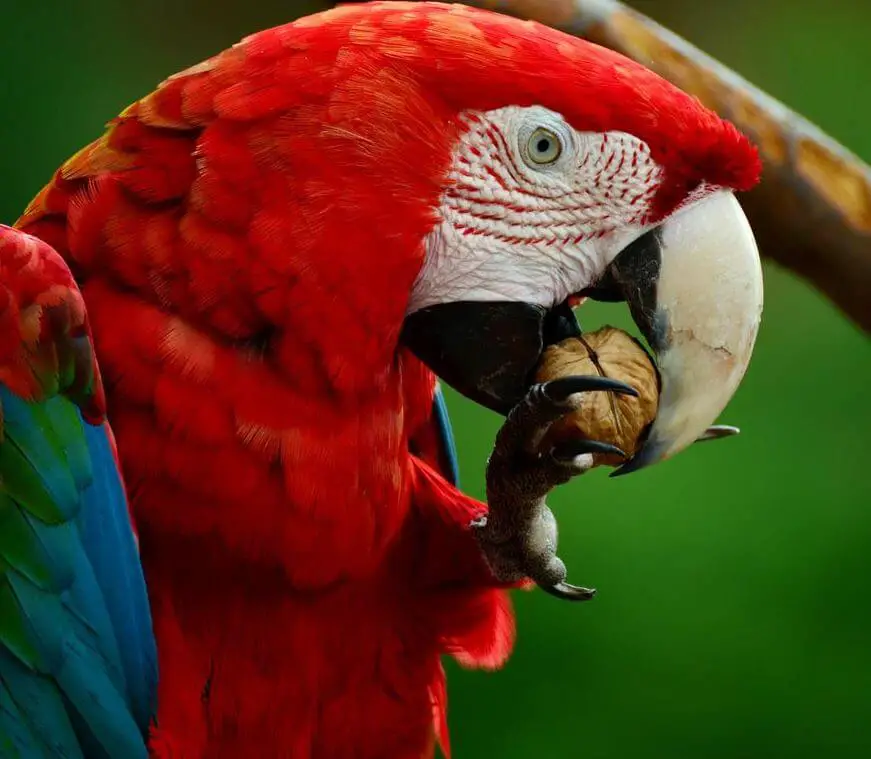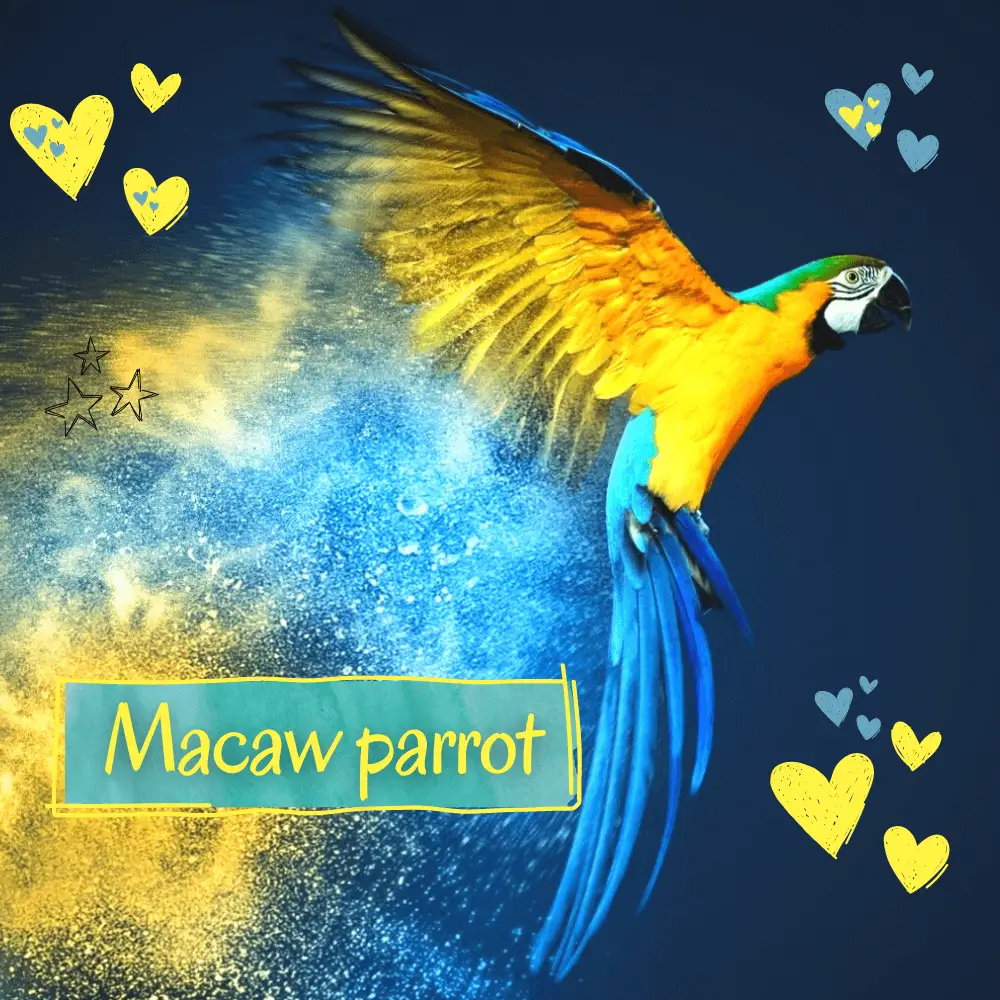Macaw parrot includes the largest members of the family Psittacidae. Not all birds whose vernacular name includes the term macaw are members of this parrot.
Members of this genus have brightly colored plumage, usually predominantly red or green, a long pointed tail, and a powerful beak. They live in tropical America.
This genus includes species of parrots of size between 30 and 90cm.
Macaws have a distinct patch of bare skin, sometimes interrupted by fine rows of feathers, on the face and extending to the base of the beak.
This feature sets them apart from other types of parrots, which have only a relatively small area of bare skin around the nostrils.
The intricate lines of fine feathers that cross this patch of bare skin have proven to be unique to each macaw, much like the human fingerprint.
Another feature that sets macaws apart from other parrots is the distinctly long tail feathers. There are six genera of macaws, with approximately 18 species.
Macaw species
According to the reference classification (version 5.2, 2015) of the International Ornithological Congress ( phylogenetic order ):

Species still alive
- Ara ararauna – Blue Macaw
- Ara glaucogularis – canindian macaw
- Ara militaris – Military Macaw
- Ara ambiguus – Buffon’s Macaw
- Ara macao – scarlet macaw
- Ara chloropterus – Red- winged Macaw
- Ara rubrogenys – Lafresnaye’s Macaw
- Ara severus – Green Macaw
- Anodorhynchus hyacinthinus – Hyacinth Macaw
Extinct species
- Tricolor Macaw – Tricolor Macaw
- Macaw guadeloupensis
- Macaw. erythrocephala
- Macaw atwoodi
- Macaw gossei
These last four are known only through travelers’ accounts. They are then classified as hypothetical although their extinction is estimated around the 18th century.
Portraits and distribution
| Species | Division | Population in 2010 | ||
| Ara ararauna – Blue Macaw (or Ara ararauna or Blue and Yellow Macaw ) |
From Panama and Guyana to Paraguay |
More than 10,000 staff down. |
||
| Ara ambiguus Buffon’s Macaw |
Panama, Honduras, Nicaragua | Fewer than 2,500 individuals Decreasing numbers Endangered species. |
||
| Ara chloropterus Green -winged Macaw (or Green-winged Macaw ) |
From Panama and Guyana to northern Argentina |
Common | ||
| Ara glaucogularis Canindé macaw (or blue-throated macaw ) |
Llanos de Mojos in northern Bolivia. | Critically endangered. | ||
| Ara macao Scarlet macaw (or Ara macao ) |
 |
Less than 50000 | ||
| Ara militaris Military macaw |
From Mexico to Bolivia |
Threatens | ||
| Ara rubrogenys – Lafresnaye’s Macaw (or Red-fronted Macaw ) |
Endemic to Bolivia south of Cochabamba and west of Santa Cruz |
2000 to 4000 individuals In danger of extinction. |
||
| Ara severus Ara vert (or severe macaw ) |
From Panama and Guyana to northern Brazil |
fairly common |
Macaw parrot food

These Parrots need a varied diet to maintain good health. There are foods specially designed for parrots, for which it is not necessary to add vitamin supplements. You can give your parrot seed mixtures, rich in proteins and lipids.
You can offer sunflower, safflower, millet, pumpkin seeds, corn, canary seed, buckwheat, wheat, oats, or even sesame.
Careful birds love to shell grains. You can soak them for twenty-four hours to make them more digestible, increase their nutrient content and reduce fat. You can add nuts, and almonds for calcium, or pistachios for vitamin A and iron.
For these preparations, always leave fresh fruits and vegetables available. Dried fruits are very sweet, they must remain a delicacy! In another genus, mealworms are also popular with parrots.
Macaw lifespan
SOURCE: Parrotsinfo
Cage for macaw parrot
Here are some bird cage recommendations. For more details, consult your pet retailer, veterinarian, or breeder.
A suitable environment is essential to the physical and mental health of pets or breeding birds. Your parrot cage becomes his refuge, a comfortable place where he will feel safe and can be entertained.
The size of the cage is important. In its resting cage, your bird must at least be able to fully spread its wings, without its tail feathers rubbing the bottom of the cage.
If your bird does regular physical activity outside of its cage, it is best if it also has a day cage or plays area. Ideally, birds should be able to fly, whether inside or outside their cage.
To ensure the health of the flock of breeding birds, it is extremely important that they fly from one perch to another. If your home is small and your bird doesn’t have enough space, an outdoor aviary can be important.
Clean bird cage
Does your cage disassemble easily in order to thoroughly clean all its corners? You can opt for a cage on wheels that is easy to move in the shower, in the garage, or on the balcony to clean with a water jet. Make sure, however, that it is not larger than the door frame.
Cages are increasingly fitted with a seed guard to minimize damage to the floor and around the cage, or acrylic panels. Most cages also include a removable tray and bottom grid for easy cleaning.
The cage should not have sharp corners or broken or rusty bars. Additionally, it should be free of lead, zinc, and copper, and the paint should be tough but non-toxic. Be sure to buy a cage from a reliable manufacturer.
If your feathered companion is a hook-billed bird, the cage should be extremely sturdy. Indeed, its doors must be equipped with a safety lock, and the troughs must be solid to minimize damage.
Make sure that the spacing between the bars of the cage is adequate for the size of your bird. Also, a wire cage with horizontal bars is essential for hook-billed birds, so they can climb to perches.

The size, dimensions, material, texture, and diameter of the perches are extremely important, as is the quantity offered in the cage. Although perches are often overlooked and their importance underestimated, they are an essential accessory in a cage.
Related article:

